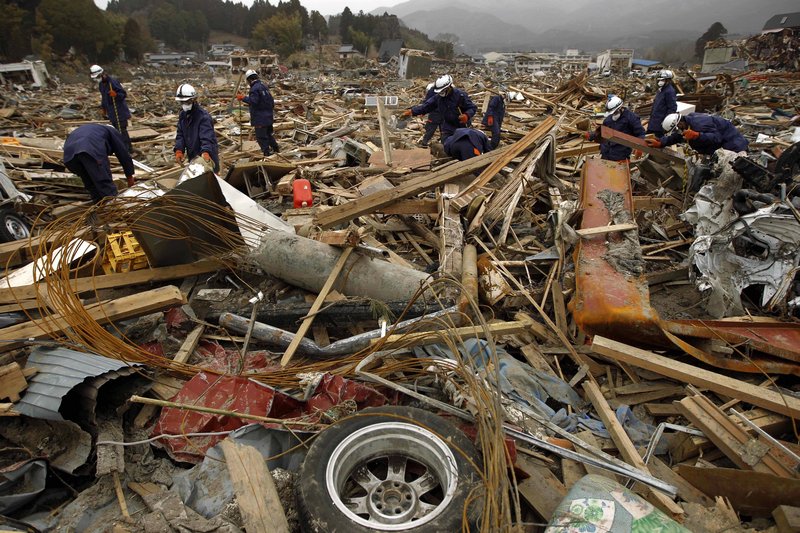FUKUSHIMA, Japan – Japanese officials reported progress Sunday in their battle to gain control over a leaking, tsunami-stricken nuclear complex, although the crisis was far from over, with the discovery of more radiation-tainted vegetables and tap water adding to public fears about contaminated food and drink.
The announcement by Japan’s Health Ministry late Sunday that tests had detected excess amounts of radioactive elements on canola and chrysanthemum greens marked a low moment in a day that had been peppered with bits of positive news:
• First, a teenager and his grandmother were found alive nine days after being trapped in their earthquake-shattered home.
• Then, the operator of the overheated nuclear plant said two of the six reactor units were safely cooled down.
“We consider that now we have come to a situation where we are very close to getting the situation under control,” Deputy Cabinet Secretary Tetsuro Fukuyama said.
Still, serious problems remained at the Fukushima Dai-ichi nuclear complex. Pressure unexpectedly rose in a third unit’s reactor, meaning plant operators may need to deliberately release radioactive steam. That has only added to public anxiety over radiation that began leaking from the plant after a monstrous earthquake and tsunami devastated northeastern Japan on March 11 and left the plant unstable. As day broke today, Japan’s military resumed dousing of the complex’s troubled Unit 4.
The safety of food and water was of particular concern. The government halted shipments of spinach from one area and raw milk from another near the nuclear plant after tests found iodine exceeded safety limits. But the contamination spread to spinach in three other prefectures and to more vegetables — canola and chrysanthemum greens. Tokyo’s tap water, where iodine turned up Friday, now has cesium. Rain and dust are also tainted.
The Health Ministry also advised Iitate, a village of 6,000 people about 19 miles northwest of the Fukushima plant, not to drink tap water due to elevated levels of iodine. Ministry spokesman Takayuki Matsuda said iodine three times the normal level was detected there — about one twenty-sixth of the level of a chest X-ray.
In all cases, the government said the radiation levels were too small to pose an immediate health risk. But Taiwan seized a batch of fava beans from Japan found with faint — and legal — amounts of iodine and cesium.
“I’m worried, really worried,” said Mayumi Mizutani, a 58-year-old Tokyo resident shopping for bottled water at a supermarket to give her visiting 2-year-old grandchild. “We’re afraid because it’s possible our grandchild could get cancer.” Forecasts for rain, she said, were also a cause for concern.
All six of the nuclear complex’s reactor units saw trouble after the disasters knocked out cooling systems. In a small advance, the plant’s operator declared Units 5 and 6 — the least troublesome — under control after their nuclear fuel storage pools cooled to safe levels. Progress was made to reconnect two other units to the electric grid and in pumping seawater to cool another reactor and replenish it and a sixth reactor’s storage pools.
But the buildup in pressure inside the vessel holding Unit 3’s reactor presented some danger, forcing officials to consider venting. The tactic produced explosions of radioactive gas during the early days of the crisis.
“Even if certain things go smoothly, there would be twists and turns,” Chief Cabinet Secretary Yukio Edano said. “At the moment, we are not so optimistic that there will be a breakthrough.”
Nuclear safety officials said one of the options could release a cloud dense with iodine as well as the radioactive elements krypton and xenon.
The plant’s operator, Tokyo Electric Power Co., temporarily suspended the plans Sunday after it said the pressure inside the reactor stopped climbing, although staying at a high level. “It has stabilized,” Tokyo Electric manager Hikaru Kuroda said.
Kuroda, who said temperatures inside the reactor reached 572 degrees Fahrenheit, said the option to release the highly radioactive gas inside is still under consideration if pressure rises.
Growing concerns about radiation add to the overwhelming chain of disasters Japan has struggled with since the 9.0-magnitude quake. It spawned a tsunami that ravaged the northeastern coast, killing 8,450 people, leaving more than 12,900 people missing, and displacing another 452,000, who are living in shelters.
Fuel, food and water remain scarce. The government in recent days acknowledged being caught ill-prepared by an enormous disaster that the prime minister has called the worst crisis since World War II.
Send questions/comments to the editors.



Success. Please wait for the page to reload. If the page does not reload within 5 seconds, please refresh the page.
Enter your email and password to access comments.
Hi, to comment on stories you must . This profile is in addition to your subscription and website login.
Already have a commenting profile? .
Invalid username/password.
Please check your email to confirm and complete your registration.
Only subscribers are eligible to post comments. Please subscribe or login first for digital access. Here’s why.
Use the form below to reset your password. When you've submitted your account email, we will send an email with a reset code.